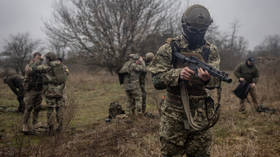Russian passenger aircraft with 220 onboard crashes in Egypt
A Russian plane carrying over 220 people from Egypt to Russia disappeared from radars, and crashed in central Sinai, according to Russian and Egyptian authorities.
Kolavia Flight 7K9268, an Airbus A321, went off radar 23 minutes after taking off from Sharm El-Sheikh International Airport, Sergey Izvolskiy told the media citing preliminary data.
The plane was carrying 217 passengers and 7 crewmembers, he added. Twenty-five of the passengers were children.
READ MORE: 'We are flying home:' Grief & disbelief in Russia over shocking Sinai air crash
Both flight data recorders from the crashed plane have been found, Egypt’s civil aviation minister said. Experts have started decoding the data, according to Egypt’s prime minister. No official causes of the crash have been declared yet.
#7K9268 flight data recorder retrieved at #SinaiCrash site, being decoded https://t.co/QRjw5cW9Xkpic.twitter.com/THFdp5bZ36
— RT (@RT_com) October 31, 2015The Russian embassy in Egypt initially said all on board were Russian citizens. Later, the Belorussian embassy said one of the passengers was Belorussian. Egyptian authorities said three of the victims were Ukrainian, but Kiev didn’t immediately confirm that.
EI-ETJ is an Airbus A321 that belongs to airline Kolavia/Metrojet. Age 18 years
https://t.co/EVPhMQGOoK
#7K9268pic.twitter.com/XUTMgx2zNn
— Flightradar24 (@flightradar24) October 31, 2015Egyptian Prime Minister Sherif Ismail confirmed that the Russian plane did go missing over Sinai and said a cabinet-level crisis committee has been convened to deal with the incident.
The crash site was discovered hours later in a desolate mountainous area of central Sinai, Egypt’s aviation ministry reported.
The plane was destroyed and all passengers and crewmembers were killed in the crash, Egyptian military and rescue officials told AP. Earlier, media reports suggested there might have been some survivors.
The Egyptian military told RT access to the crash site may be difficult for the press due to the volatile security situation in the Sinai. Large parts of the peninsula are dangerous due to the presence of militants, with only coastal areas in the north and south adequately guarded by security forces. The crash site is in the Hassana area 35 km south of Arish, the largest city in the Sinai.
04:13 UTC FR24 lost coverage of flight #7K9268 from Sharm el-Sheikh to St. Petersburg
https://t.co/RlcJTpDHwIpic.twitter.com/DfOPFJXYqq
— Flightradar24 (@flightradar24) October 31, 2015The flight was traveling from the Egyptian resort to St. Petersburg. It belonged to the Kogalymavia airline, which also uses the brand name Metrojet, an operator popular among Russian tourists going to Egypt. The plane was supposed to contact air traffic in Turkish Cyprus’ Larnaca after leaving Egypt’s airspace, but failed to do so.
The tourist operator Brisco charted the ill-fated flight. The company is a business affiliate of Metrojet and they said the captain of the Airbus was an experienced pilot familiar with the aircraft.
“The captain was Velary Nemov, who has 12,000 flight hours under his belt, so he is definitely an experienced man. Of those, some 3,800 hours he spent piloting Airbus 320s. So we don’t have any reason to suspect human error from the crew,” a spokesman for Brisco said.
The plane climbed to its designated altitude of over 10,000 meters before rapidly losing speed, dropping and then vanishing from radar. Some reports in the Egyptian media cited eyewitnesses as saying the plane was on fire as it fell.
A source at Sharm El-Sheikh Airport told RIA Novosti the pilot of the missing plane requested a change of course, saying the jet would have to land in Cairo. The source said the crew of the crashed plane had complained to the airport’s technical service that the jet had engine problems.
It's NOT confirmed that this flight has crashed. It descended 5000 feet before Flightradar24 coverage was lost. https://t.co/w5QKC7BXJX
— Flightradar24 (@flightradar24) October 31, 2015The rapid drop the Airbus 321 reportedly experienced before crashing indicates pretty unusual circumstances and would suggest an emergency descent maneuver conducted by the crew, Captain Richard Woodward, former vice-president of the Australian and International Pilots' Association (AIPA), told RT.
“If engines had failed, that would give you a dramatic loss of speed initially, but the crew would have lowered the nose and commit what is called a glide descent,” he explained. “My initial thought was that it might have been an emergency descent by the crew because they had a pressurization problem or dare I say perhaps a bomb on board.”
Russia has declared Sunday a day of national mourning for the crash victims.
Metrojet had a fatal incident in 2011, when one of its planes caught fire on a runway in Surgut Airport in Russia’s Urals. Three people died and 40 were injured as the plane burned out in just 10 minutes.
The last large-scale Russian airline incident happened in November 2013, when Tatarstan Airlines Flight 363 crashed at Kazan International Airport while attempting to land. Fifty people died in the incident.












